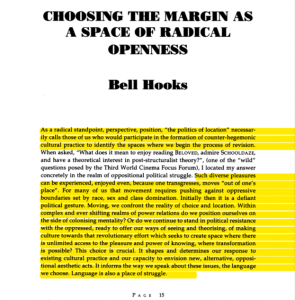

However, in her attempt to introduce these valuable perspectives, I think hooks ultimately reinforces the binary logic of domination she considers to be the root of oppression. Most importantly, she airs some of the perspectives which are common among poor or non-white women yet neglected by white bourgeois feminists. She proposes concrete practices which align with her theoretical proclamations. On the positive side, hooks is excellent at identifying problems and courageous at putting forth potential solutions. There are some aspects of this book I find praiseworthy and other elements I find problematic, but regardless of which arguments fall in which categories, I think today's feminists would do well to take up hooks's call to continually re-evaluate whatever the hegemonic consensus of the day is.

This sense of wholeness, impressed upon our conscious- ness by the structure of our daily lives, provided us an opposi- tional world view-a mode of seeing unknown to most of our oppressors, that sustained us, aided us in our struggle to trans- cend poverty and despair, strengthened our sense of self and our solidarity.Although this book presented a critical challenge to feminist orthodoxy at the time it was published, it has ironically become the contemporary feminist party line. Our survival depended on an ongoing public awareness of the separation between margin and center and an ongoing private acknowledgment that we were a necessary, vital part of that whole. This mode of seeing reminded us of the existence of a whole universe, a main body made up of both margin and center. We focused our attention on the center as well as on the margin. We looked both from the outside in and and from the inside out. Living as we did-on the edge-we deve- loped a particular way of seeing reality. To not return was to risk being punished.


We had always to return to the margin, to cross the tracks, to shacks and abandoned houses on the edge of town. We could enter that world but we could not live there. Across those tracks was a world we could work in as maids, as janitors, as prostitutes, as long as it was in a service capacity. Across those tracks were paved streets, stores we could not enter, restaurants we could not eat in, and people we could not look directly in the face. As black Americans living in a small Kentucky town, the railroad tracks were a daily reminder of our margin- ality. Preface To be in the margin is to be part of the whole but outside the main body.


 0 kommentar(er)
0 kommentar(er)
